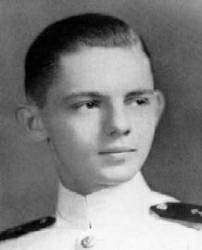Robert G. Bradley
| Robert G. Bradley | |
|---|---|
 Robert G. Bradley | |
| Birth name | Robert Graham Bradley |
| Born |
26 September 1921 Washington, D.C. |
| Died |
24 October 1944 (aged 23) At Sea, USS Princeton (CVL-23) |
| Buried at | Missing, lost at sea |
| Allegiance |
|
| Service/branch |
|
| Years of service | 1942 – 1944 |
| Rank |
|
| Service number | 165385 |
| Battles/wars | World War II |
| Awards |
|
Robert Graham Bradley (26 September 1921 – 24 October 1944) was a United States Navy Lieutenant during World War II. He was posthumously awarded the Navy Cross for actions during the Battle of Leyte Gulf on USS Princeton (CVL-23). He was the namesake of USS Robert G. Bradley (FFG-49).
Biography
Robert Graham Bradley was born in Washington, D.C., on 26 September 1921. He was appointed to the United States Naval Academy on 9 June 1939, and graduated on 19 June 1942. He completed instruction at the Atlantic Subordinate Command, Service Force, Norfolk, Va. (3 July – 27 October 1942), and on 29 October reported to New York Shipbuilding Corporation, Camden, New Jersey, for the fitting out of small aircraft carrier USS Princeton (CVL-23). He served as a member of the ship’s company when Princeton was commissioned on 25 February 1943, and while on board received promotions to lieutenant, junior grade and lieutenant (1 May 1943 and 1 July 1944, respectively), as she took part in operations ranging from the occupation of Baker Island (September 1943) to the Battle of Leyte Gulf (October 1944).[1]
While Princeton steamed with Task Group 38.3 (part of Task Force 38) in Leyte Gulf off the east coast of Luzon, Philippines (24 October 1944), a Japanese plane, tentatively identified as a Yokosuka D4Y1 Type 2 [Judy], attacked the ship. Its bomb penetrated the flight, hangar, and main decks and exploded, igniting an inferno that swept across the hangar deck. Explosions rocked the carrier, but Bradley, the ship’s assistant first lieutenant, led a repair party and battled the blaze on the second and third decks. Light cruisers USS Birmingham (CL-62) and USS Reno (CL-96), and destroyers USS Gatling (DD-671), USS Irwin (DD-794), and USS Morrison (DD-560), also fought the fire.[1]
The intense heat compelled Bradley and his men to abandon their efforts, and after verifying that no wounded men remained behind, he entered the water at 1005, rescued soon thereafter by Morrison. Their success in fighting the fire led many of the men to believe that if they could clear the smoke from Princeton’s largely undamaged machinery spaces, they could raise steam and save the ship.[1]
Bradley thus valiantly returned to Princeton (1300) from Morrison—which lay alongside Princeton’s starboard quarter to play her hoses onto the flames and became temporarily wedged between two of the carrier’s overhanging stacks. A submarine and air alert sounded 30 minutes later and Birmingham and Morrison, the two closest ships, pulled away from Princeton to take their antisubmarine stations. The determined firefighting efforts had nearly controlled the fire, but it raged again during the ensuing lull. Following the alert, Birmingham and Morrison closed and attempted to secure a line to Princeton. The cruiser succeeded on her third try (1515), but the flames touched off four hundred 100-pound bombs stowed aft in the torpedo magazine (1523). The resulting explosion blew off the upper part of the carrier’s stern, killing Bradley and every man in the vicinity.[1]
Birmingham, Gatling, Irwin, and Morrison all sustained damage by rolling against the stricken carrier or by fragments from the explosion of Princeton’s magazines—the detonation devastated Birmingham, which lay alongside the carrier and lost 229 men killed, four missing, 211 seriously wounded, and 215 with minor wounds. In addition, a jeep (used to tow aircraft) fell from Princeton's flight deck, damaging Morrison’s bridge. Reno and Irwin scuttled Princeton.[1]
Bradley had repeatedly risked his life, entering the most dangerous areas below deck to ascertain the extent of the damage and to fight the fires blazing on board. For his “outstanding fortitude, great personal valor, and self-sacrificing devotion to the completion of an extremely perilous task,” as well as his “extraordinary heroism,” Bradley received the Navy Cross posthumously.[1]
Bradley's name appears on the Tablets of the Missing, Manila American Cemetery, Manila, Philippines.[2]
Navy Cross citation

The Commander In Chief Pacific Fleet awarded Bradley the Navy Cross for actions while serving aboard Princeton 24 October 1944 with the following citation:
The President of the United States of America takes pride in presenting the Navy Cross (Posthumously) to Lieutenant Robert Graham Bradley (NSN: 0-165385), United States Navy, for extraordinary heroism and distinguished service in the line of his profession while serving on board the Light Aircraft Carrier U.S.S. PRINCETON (CVL-23), during operations against enemy Japanese forces in Philippine waters during the Battle of Leyte Gulf on 24 October 1944. After his ship was hit with a bomb from an enemy aircraft, Lieutenant Bradley led efforts to control the resulting fires and explosions until conditions became unbearable and personnel on the after part of the ship were ordered to leave. He supervised the safe departure of his men, and he was among the last to leave, and after being rescued by a destroyer, returned to the ship and continued to fight fires and control explosions. His courage and skill were in keeping with the highest traditions of the naval service.[3]— Commander In Chief Pacific Fleet, 17 November 1944)
References
This article incorporates text from the public domain Dictionary of American Naval Fighting Ships. The entry can be found here.
- 1 2 3 4 5 6 "USS Robert G. Bradley". Public Domain US Navy Dictionary of American Naval Fighting Ships. Retrieved 2014-06-07.
- ↑ "Robert G. Bradley". American Battle Monuments Commission. Retrieved 2014-06-07.
- ↑ "Robert Graham Bradley". Military Times. Retrieved 2014-06-07.
External links
- USS Bradley namesake page at the Wayback Machine (archived 30 April 2006)